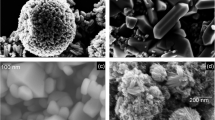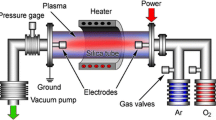Abstract
A hot wire chemical vapor deposition technique is described for synthesis of 1D nanostructures of a controlled morphology, stoichiometry, and composition. The synthesis involves the evaporation and condensation of metal oxide vapor through the reaction of oxygen with the hot filaments of respective transition metals. The stoichiometry and morphology of MoO3 and WO3 were modulated by varying the filament temperature and partial pressure of oxygen in the growth chamber. Based on the results under different conditions, a morphological phase diagram, and a growth model based on the extent of gas phase supersaturation were developed to understand the growth mechanism. Further, ternary transition metal oxide, NiMoO4 was synthesized as a proof-of-concept for tuning the composition of deposition through simultaneous evaporation of two metal oxides.







Similar content being viewed by others
References
V.E. Henrich and P.A. Cox: The Surface Science of Metal Oxides (Cambridge: Cambridge University Press, 1996).
A.C. Papageorgiou, N.S. Beglitis, C.L. Pang, G. Teobaldi, G. Cabailh, Q. Chen, A.J. Fisher, W.A. Hofer, and G. Thornton: Electron traps and their effect on the surface chemistry of TiO2(110). Proc. Natl. Acad. Sci. U. S. A. 107(6), 2391–2396 (2010).
S. Wendt, R. Schaub, J. Matthiesen, E.K. Vestergaard, E. Wahlström, M.D. Rasmussen, P. Thostrup, L.M. Molina, E. Lægsgaard, I. Stensgaard, B. Hammer, and F. Besenbacher: Oxygen vacancies on TiO2(110) and their interaction with H2O and O2: A combined high-resolution STM and DFT study. Surf. Sci. 598(1–3), 226–245 (2005).
O. Bikondoa, C.L. Pang, R. Ithnin, C.A. Muryn, H. Onishi, and G. Thornton: Direct visualization of defect-mediated dissociation of water on TiO2(110). Nat. Mater. 5(3), 189–192 (2006).
U. Diebold: Intrinsic defects on a TiO2(110) surface and their reaction with oxygen: A scanning tunneling microscopy study. Surf. Sci. 411, 137–153 (1998).
F. Esch, S. Fabris, L. Zhou, T. Montini, C. Africh, P. Fornasiero, G. Comelli, and R. Rosei: Electron localization determines defect formation on ceria substrates. Science 309(5735), 752–755 (2005).
W.S. Epling, C.H.F. Peden, M.A. Henderson, and U. Diebold: Evidence for oxygen adatoms on TiO2(110) resulting from O2 dissociation at vacancy sites. Surf. Sci. 412–413, 333–343 (1998).
M.D. Rasmussen, L.M. Molina, and B. Hammer: Adsorption, diffusion, and dissociation of molecular oxygen at defected TiO2(110): A density functional theory study. J. Chem. Phys. 120, 988–997 (2004).
R. Schaub: Oxygen-mediated diffusion of oxygen vacancies on the TiO2(110) surface. Science 299, 377–379 (2003).
X. Wu, A. Selloni, M. Lazzeri, and S.K. Nayak: Oxygen vacancy mediated adsorption and reactions of molecular oxygen on the TiO2(110) surface. Phys. Rev. B 68, 241402 (2003).
J. Son, J. Wei, D. Cobden, G. Cao, and Y. Xia: Hydrothermal synthesis of monoclinic VO2 micro- and nanocrystals in one step and their use in fabricating inverse opals. Chem. Mater. 22(10), 3043–3050 (2010).
E. Della Gaspera, M. Guglielmi, A. Martucci, L. Giancaterini, and C. Cantalini: Enhanced optical and electrical gas sensing response of sol–gel based NiO–Au and ZnO–Au nanostructured thin films. Sens. Actuators, B 164(1), 54–63 (2012).
M.H. Suhail, G.M. Rao, and S. Mohan: DC reactive magnetron sputtering of titanium-structural and optical characterization of TiO2 films. J. Appl. Phys. 71(3), 1421–1427 (1992).
P. Padmini, T. Taylor, M. Lefevre, A. Nagra, R. York, and J. Speck: Realization of high tunability barium strontium titanate thin films by rf magnetron sputtering. Appl. Phys. Lett. 75(20), 3186–3188 (1999).
A. Nemetz, A. Temmink, K. Bange, S. Cordoba de Torresi, C. Gabrielli, R. Torresi, and A. Hugo-Le Goff: Investigations and modelling of e−-beam evaporated NiO(OH)x films. Sol. Energy Mater. Sol. Cells 25(1–2), 93–103 (1992).
A.C. Jones: Molecular design of improved precursors for the MOCVD of electroceramic oxides. J. Mater. Chem. 12(9), 2576–2590 (2002).
C. Luyo, R. Ionescu, L.F. Reyes, Z. Topalian, W. Estrada, E. Llobet, C.G. Granqvist, and P. Heszler: Gas sensing response of NiO nanoparticle films made by reactive gas deposition. Sens. Actuators, B 138(1), 14–20 (2009).
B. Xiang, P. Wang, X. Zhang, S.A. Dayeh, D.P.R. Aplin, C. Soci, D. Yu, and D. Wang: Rational synthesis of p-type zinc oxide nanowire arrays using simple chemical vapor deposition. Nano Lett. 7(2), 323–328 (2007).
W. Li, F. Cheng, Z. Tao, and J. Chen: Vapor-transportation preparation and reversible lithium intercalation/deintercalation of α-MoO3 microrods. J. Phys. Chem. B 110(1), 119–124 (2006).
X. Lu, T. Zhai, X. Zhang, Y. Shen, L. Yuan, B. Hu, L. Gong, J. Chen, Y. Gao, J. Zhou, Y. Tong, and Z.L. Wang: WO3–x@Au@MnO2 core–shell nanowires on carbon fabric for high-performance flexible supercapacitors. Adv. Mater. 24(7), 938–944 (2012).
T. Chirayil, P.Y. Zavalij, and M.S. Whittingham: Hydrothermal synthesis of vanadium oxides. Chem. Mater. 10(10), 2629–2640 (1998).
S.H. Lee, R. Deshpande, P.A. Parilla, K.M. Jones, B. To, A.H. Mahan, and A.C. Dillon: Crystalline WO3 nanoparticles for highly improved electrochromic applications. Adv. Mater. 18(6), 763–766 (2006).
J. Thangala, S. Vaddiraju, R. Bogale, R. Thurman, T. Powers, B. Deb, and M.K. Sunkara: Large-scale, hot-filament-assisted synthesis of tungsten oxide and related transition metal oxide nanowires. Small 3(5), 890–896 (2007).
V. Chakrapani, J. Thangala, and M.K. Sunkara: WO3 and W2N nanowire arrays for photoelectrochemical hydrogen production. Int. J. Hydrogen Energy 34(22), 9050–9059 (2009).
J.I. Pankove: Optical Processes in Semiconductors (New York: Dover, 1971).
D. Su, S. Dou, and G. Wang: Mesocrystal Co3O4 nanoplatelets as high capacity anode materials for Li-ion batteries. Nano Res. 7(5), 794–803 (2014).
A.M. Morales and C.M. Lieber: A laser ablation method for the synthesis of crystalline semiconductor nanowires. Science 279(5348), 208–211 (1998).
Y. Wu, H. Yan, M. Huang, B. Messer, J.H. Song, and P. Yang: Inorganic semiconductor nanowires: Rational growth, assembly, and novel properties. Chemistry 8(6), 1260–1268 (2002).
L. Dong, T. Gushtyuk, and J. Jiao: Synthesis, characterization, and growth mechanism of self-assembled dendritic CdS nanorods. J. Phys. Chem. B 108(5), 1617–1620 (2004).
H. Yu and W.E. Buhro: Solution–liquid–solid growth of soluble GaAs nanowires. Adv. Mater. 15 (5), 416–419 (2003).
R.Q. Zhang, Y. Lifshitz, and S.T. Lee: Oxide-assisted growth of semiconducting nanowires. Adv. Mater. 15(7–8), 635–640 (2003).
G.W. Sears: Growth of polymer crystals by a screw dislocation mechanism. J. Polym. Sci., Part B: Polym. Lett. 2(12), 1117–1120 (1964).
Y. Hsu and S. Lu: Vapor−solid growth of Sn nanowires: Growth mechanism and superconductivity. J. Phys. Chem. B 109(10), 4398–4403 (2005).
Y. Xia, P. Yang, Y. Sun, Y. Wu, B. Mayers, B. Gates, Y. Yin, F. Kim, and H. Yan: One-dimensional nanostructures: Synthesis, characterization, and applications. Adv. Mater. 15(5), 353–389 (2003).
G. Cao and Y. Wang: Nanostructures and nanomaterials: Synthesis, properties, and applications (Singapore: World Scientific, 2011).
J. Zhang, F. Jiang, and L. Zhang: Fabrication of single-crystalline semiconductor CdS nanobelts by vapor transport. J. Phys. Chem. B 108(22), 7002–7005 (2004).
Y. Yin, G. Zhang, and Y. Xia: Synthesis and characterization of MgO nanowires through a vapor-phase precursor method. Adv. Funct. Mater. 12(4), 293–298 (2002).
P. Yang and C.M. Lieber: Nanorod-superconductor composites: A pathway to materials with high critical current densities. Science 273(5283), 1836–1840 (1996).
B.W. Mwakikunga, E. Sideras-Haddad, A. Forbes, and C. Arendse: Raman spectroscopy of WO3 nano-wires and thermo-chromism study of VO2 belts produced by ultrasonic spray and laser pyrolysis techniques. Phys. Status Solidi A 205(1), 150–154 (2008).
M. Boulova, N. Rosman, P. Bouvier, and G. Lucazeau: High-pressure Raman study of microcrystalline WO3 tungsten oxide. J. Phys.: Condens. Matter 14(23), 5849 (2002).
V.E. Henrich, G. Dresselhaus, and H.J. Zeiger: Observation of two-dimensional phases associated with defect states on the surface of TiO2. Phys. Rev. Lett. 36(22), 1335–1339 (1976).
C.G. Granqvist: Electrochromic oxides: A bandstructure approach. Sol. Energy Mater. Sol. Cells 32(4), 369–382 (1994).
J.H. Ryu, S. Koo, J. Yoon, C.S. Lim, and K.B. Shim: Synthesis of nanocrystalline MMoO4 (M = Ni, Zn) phosphors via a citrate complex route assisted by microwave irradiation and their photoluminescence. Mater. Lett. 60(13–14), 1702–1705 (2006).
P.K. Pandey, N.S. Bhave, and R.B. Kharat: Preparation and characterization of spray deposited NiMoO4 thin films for photovoltaic electrochemical studies. Mater. Res. Bull. 41(6), 1160–1169 (2006).
ACKNOWLEDGMENTS
The authors would like to thank Qi Wang for his assistance with the UPS measurements. Financial supports of National Science Foundation grant (CBET, Award No. 1511733) and Rensselaer Polytechnic Institute are gratefully acknowledged.
Author information
Authors and Affiliations
Corresponding author
Rights and permissions
About this article
Cite this article
Chakrapani, V., Brier, M., Puntambekar, A. et al. Modulation of stoichiometry, morphology and composition of transition metal oxide nanostructures through hot wire chemical vapor deposition. Journal of Materials Research 31, 17–27 (2016). https://doi.org/10.1557/jmr.2015.366
Received:
Accepted:
Published:
Issue Date:
DOI: https://doi.org/10.1557/jmr.2015.366




